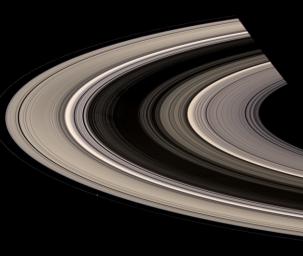
|
Out of Darkness
- Click the image above for a larger view
- Full-Res JPEG (1005 x 849) (92.8 kB)
- Full-Res TIFF (1005 x 849) (2.6 MB)
Caption:
Saturn's rings burst out of shadow and curve gracefully around the planet. Prometheus (86 kilometers, or 53 miles across at its widest point) appears as a bright speck touching the inside of the narrow F ring. Atlas (30 kilometers, 19 miles across at its widest point) is also visible, faintly, upward and to the left of Prometheus, just outside the A ring edge.
Saturn's shadow cuts across the rings at top right.
Several dark, narrow spokes are faintly visible near the B-ring ansa, left of center.
This view looks toward the unilluminated side of the rings from about 13 degrees above the ringplane. Images taken using red, green and blue spectral filters were combined to create this natural color view. The images were obtained with the Cassini spacecraft wide-angle camera on July 4, 2008 at a distance of approximately 1.2 million kilometers (775,000 miles) from Saturn. Image scale is 71 kilometers (44 miles) per pixel.
Background Info:
The Cassini-Huygens mission is a cooperative project of NASA, the European Space Agency and the Italian Space Agency. The Jet Propulsion Laboratory, a division of the California Institute of Technology in Pasadena, manages the mission for NASA's Science Mission Directorate, Washington, D.C. The Cassini orbiter and its two onboard cameras were designed, developed and assembled at JPL. The imaging operations center is based at the Space Science Institute in Boulder, Colo.
For more information about the Cassini-Huygens mission visit http://saturn.jpl.nasa.gov/ . The Cassini imaging team homepage is at http://ciclops.org .
Cataloging Keywords:
| Name | Value | Additional Values |
|---|---|---|
| Target | Saturn Rings | Atlas, F Ring, Prometheus, Saturn |
| System | Saturn | |
| Target Type | Ring | Planet, Satellite |
| Mission | Cassini-Huygens | |
| Instrument Host | Cassini Orbiter | |
| Host Type | Orbiter | |
| Instrument | Imaging Science Subsystem (ISS) | |
| Detector | Wide Angle Camera | |
| Extra Keywords | Color, Shadow, Visual | |
| Acquisition Date | ||
| Release Date | 2008-08-25 | |
| Date in Caption | 2008-07-04 | |
| Image Credit | NASA/JPL/Space Science Institute | |
| Source | photojournal.jpl.nasa.gov/catalog/PIA10454 | |
| Identifier | PIA10454 | |
